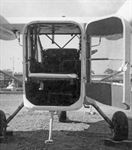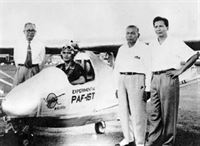Фотографии
-
Although not the most elegant of designs, the XL-15 Tagak was the third of the PAF-IST’s collaborative efforts, and offered a rugged, capacious aircraft made with locally-sourced materials.
Самолёты на фотографии: IST XL-15 Tagak - Филиппины - 1954
-
The XL-15 Tagak was completed in 1954 and made its first flight late that year. It was modified during 1955-56 to provide increased rudder area and a shimmy-damper in the nosewheel undercarriage.
Самолёты на фотографии: IST XL-15 Tagak - Филиппины - 1954
-
The aft end of the Tagak’s main fuselage pod was extensively glazed, the type being conceived as an air ambulance and liaison aircraft, although it is unlikely it was ever intended to be put into production as such; it was essentially another Wobex-research design.
Самолёты на фотографии: IST XL-15 Tagak - Филиппины - 1954
-
The glazed rear door of the Tagak’s fuselage pod was hinged on the starboard side and opened to provide access to the 10ft 6in (3-3m)-long and 3ft 1 1/2in (0-96m)-wide cabin, which could accommodate up to two stretchers, one on top of the other, plus a medical attendant beside the pilot.
Самолёты на фотографии: IST XL-15 Tagak - Филиппины - 1954
-
The XL-15’s cockpit layout was somewhat spartan, with only the most basic instrumentation provided for the test-flight programme. The Tagak was fitted with a Lycoming O-425 six-cylinder engine driving a fixed-pitch two-bladed propeller.
Самолёты на фотографии: IST XL-15 Tagak - Филиппины - 1954
-
Регистрационный номер: PI-X-104 [4] The Maya under construction in Manila. The fuselage was of semi-monocoque structure with wooden stringers and covered with Wobex, the experimental woven-bamboo material made from locally-sourced supplies of the grass.
Самолёты на фотографии: IST XL-14 Maya - Филиппины - 1953
-
Регистрационный номер: PI-X-104 [4] Final adjustments are made to the complete XL-14 at Manila before its first flight, which some sources state was in December 1952, although there appears to be no definitive information on an exact date, and it may have been early 1953.
Самолёты на фотографии: IST XL-14 Maya - Филиппины - 1953
-
Регистрационный номер: PI-X-104 [4] Looking like a Cessna O-1 Bird Dog with twin fins, the Maya prepares to alight after a test flight.
Самолёты на фотографии: IST XL-14 Maya - Филиппины - 1953
-
Регистрационный номер: PI-X-104 [4] Nicknamed "the Flying Basket" owing to its woven-bamboo construction, the sole PAF-IST XL-14 Maya, bearing its experimental category registration PI-X-104 on its fins, taxies out for a test flight circa early 1953. The machine was a co-operative materials-research project developed by the Institute of Science & Technology (IST) and the Philippine Air Force (PAF).
Самолёты на фотографии: IST XL-14 Maya - Филиппины - 1953
-
Conceived as a light touring and training aircraft, the L-17 Musang was a departure for the PAF-IST design team in that it sported a low wing and did not incorporate the use of Wobex. Making its maiden flight in October 1956, the Musang did not go into production; and, like its PAF-IST stablemates, only one example was built.
Самолёты на фотографии: IST XL-17 Musang - Филиппины - 1956
-
Самолёты на фотографии: IST L-10 Balang - Филиппины - 1953
-
The XL-10 Balang was a simple powered glider with a span of 39 ft 4in (12m) and a length of 20ft 4in (6-2m). It was completed and flown, although exactly when the first flight was made remains unconfirmed.
Самолёты на фотографии: IST L-10 Balang - Филиппины - 1953
Статьи
- -
- A.Tincopa - Marked by misfortune
- C.Gibson - Perfect 10
- C.Habermehl, R.Hopkins III - Stratojets in Blighty
- D.Stringer - The Viscount comes to America (1)
- L.Andersson - Sweden's ghost rocket
- N.Stroud - Bamboo birds & other rare species
- N.Stroud - Vikings in Africa /The John Stroud Archive/
- N.Yakubovich - Shcherbakov's forgotten workhorse
- P.Davidson - Off the Beaten Track...
- P.Jarrett - The world's first aeronautical exhibition
- R.Flude, G.Alegi - The Rome-Tokyo express. The Regia Aeronautica's 1942 route-proving flight to Japan /The Axis's wartime air links/ (1)
- R.Pegram - Imperial Airways. The 1930s: a cause for concern?
- T.Eeles - Brute force & innovation











